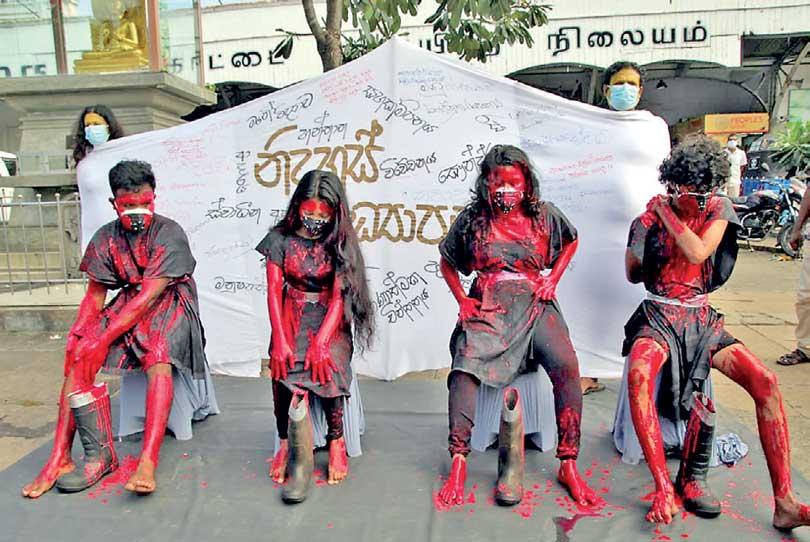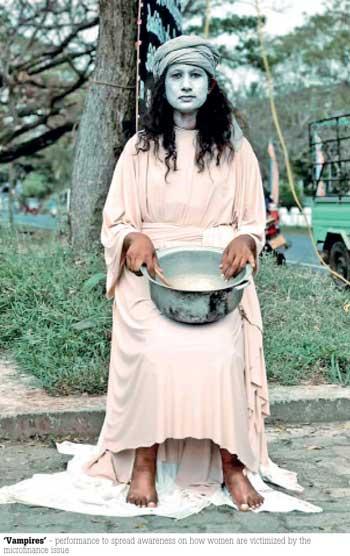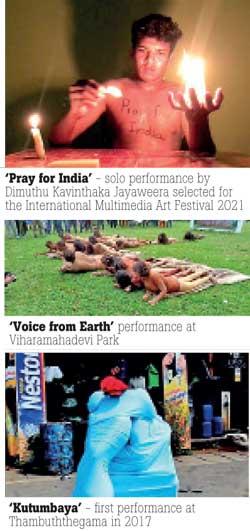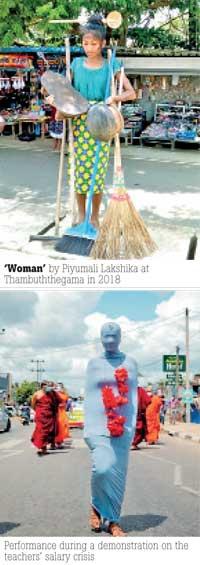Reply To:
Name - Reply Comment
Developing a narrative via Performance Art

‘Blood’ - performance to voice in favour of free education

Back in 1974, Marina Abramovic´of of Serbia laid out 72 items on a trestle table and asked the public to use them on her in any way they saw fit. The items included everything from roses, olive oil to a pistol with six bullets in it. In one of the interviews she recalled that she was ready to die that day. But six hours later, she walked away from the gallery in Belgrade, Serbia, dripping with blood and tears, while considering herself lucky as she was alive. Abramovic´of is acknowledged as one of the pioneers of Performance Art and a remarkable figure in  Serbian Conceptual and Performance Art.
Serbian Conceptual and Performance Art.
Today, Performance Art is tried and experimented in most parts of the world including South East Asia. In Sri Lanka, a small group of artistes is experimenting their creativity through Performance Art to engage audiences and develop a dialogue about this powerful form of Art. This is the story of Ogha Collective.
Having pursued higher studies at the University of Visual and Performing Arts, Kithsiri Sampath Bandara, founder of the Collective returned to Thambuththegama, his hometown, where he started teaching art to students in his area. “We had our first performance at the Thambuththegama town back in 2017. Many students interested in arts have joined us in our projects. We try to address timely issues such as deforestation, media freedom, the drug menace etc. Our first performance was called ‘Kutumbaya’ which translates to family.”
However, the concept of Performance Art is still new to
Sri Lanka, especially in rural parts of the island. But Bandara says that people seem to be curious about what it is all about. “Society still doesn’t understand what Performance Art is all about. Most of the time Performance Art is confined to art galleries in Colombo. But this is a powerful way of delivering a message to the public. People are slowly grabbing the concept but it will take some time.”The Ogha Collective has made history as the first group to engage in Performance Art in Sri Lanka.
Society still doesn’t understand what Performance Art is all about. Most of the time Performance Art is confined to art galleries in Colombo.”
 The group develops their own props as the students have a depth of knowledge in the field of arts. Props used for performances such as ‘Vampires’ that addressed the microfinance issue inHingurakgoda spoke volumes about theircreativity.The concepts for each of these performances are also scripted by themselves. “We combine our performances with visual arts. It goes hand in hand. Our group comprise of around 15 students who are studying at the university and some who are still doing A/Ls. They too have creative ideas and we try to give something new to the audience every time we do a performance,” opined Bandara.
The group develops their own props as the students have a depth of knowledge in the field of arts. Props used for performances such as ‘Vampires’ that addressed the microfinance issue inHingurakgoda spoke volumes about theircreativity.The concepts for each of these performances are also scripted by themselves. “We combine our performances with visual arts. It goes hand in hand. Our group comprise of around 15 students who are studying at the university and some who are still doing A/Ls. They too have creative ideas and we try to give something new to the audience every time we do a performance,” opined Bandara.
In Pali, Ogha directly translates to ‘a flood ; that which sweeps a man away from emancipation’. Arts is a form of liberation, a medium to free people from legal, social, cultural and political restrictions. This has been justified in the various performances done by the Collective. During a massive campaign that was launched to stop the ongoing ecocide, the Ogha Collective did a performance titled ‘A Voice from the Earth’ at the Viharamahadevi Park.
The performance was directed under the guidance of Janani Cooray, a contemporary Performance Artist in the country. The Collective has also joined demonstrations that voiced against the teachers’ salary crisis, the Kotelawala Defense University Bill etc and even demonstrations that voice for free education as well. “We have participated in several international competitions as well. Our objective is to develop a dialogue among the public on various social issues. For that, Performance Art is a way of expanding their views on the topic.”
 Even though various genres of art have become popular in other parts of the world, Sri Lanka still has a long way to go in placing value to various forms of art. This is evident with numerous challenges Bandara has to face. “When working with students from rural areas we should be ready to face a fair share of challenges as well. Some parents are reluctant to send their children when they see them on television. Sometimes students will have to bear a cost when travelling to other parts of the country. There are instances when students can’t afford the cost. But all of them have a lot of dedication to learn and experiment new concepts of Performance Art.”
Even though various genres of art have become popular in other parts of the world, Sri Lanka still has a long way to go in placing value to various forms of art. This is evident with numerous challenges Bandara has to face. “When working with students from rural areas we should be ready to face a fair share of challenges as well. Some parents are reluctant to send their children when they see them on television. Sometimes students will have to bear a cost when travelling to other parts of the country. There are instances when students can’t afford the cost. But all of them have a lot of dedication to learn and experiment new concepts of Performance Art.”
Bandara conducts rehearsals at his house and he hopes to have performances in every part of the island in future. “My objective is to make people aware of the concept of performance art. We are hoping to have a performance inside an art gallery to spread the word about Performance Art to a wider audience.”
Image courtesy
Ogha Collective